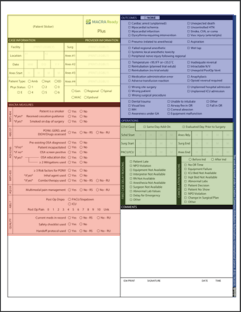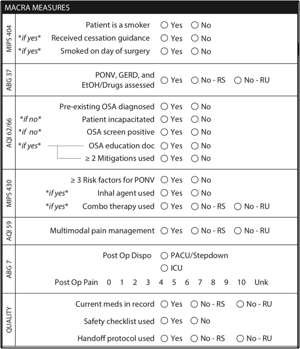

BUILDING THE 2019 MACRA FORMS
We put simplicity and accessibility in the driver’s seat as the Graphium Health team began to design our paper forms for MACRA reporting in 2019. Here is a snapshot of the final product, but for a full-sized look, you can visit our website to download full-sized versions.
We have 4 forms available in total:
- MACRA Simple
- MACRA Simple w/OB
- MACRA Plus
- MACRA Plus w/OB
A cover letter comes with each form that explains the value of using these forms plus a definition of each measure that is collected on the forms. If you don’t have any OB practice, you can simply leave the OB forms out. On the other hand, if you do perform OB cases, they are handled a little differently, and we are happy to field any questions you have at any time.
MACRA SIMPLE vs MACRA PLUS
Case Metadata (Simple and Plus)

The section highlighted in yellow here captures the identity of the surgeon & anesthesiologist, what type of anesthetic that’s used, and other case metadata. We make an effort to capture the least amount of data required to determine which cases apply to our selected measures. While Anesthesia Start Time helps us decipher which case is being performed (in the event that a patient has multiple procedures in one day), one question that arises frequently is “Where is the Anesthesia End Time?” As it turns out, we don’t actually need that information for any of our measures or reporting, so we leave it off to simplify the providers’ workflow even further.
Outcomes (Simple and Plus)

In the blue section we track 39 different major and minor outcomes. Some of these apply to MACRA but the majority do not. So why track those? Because we offer a much richer experience than just MACRA compliance. Tracking these outcomes allows us to offer robust Quality program for OPPE and Joint Commission Quality reports. To these ends, we also ask process quality questions like medications documented, handoff protocol used, safety checklist used. It’s easy data to collect that makes our clients able to “brag” to their hospital administrators.
MACRA (Simple and Plus)

The red section is the MACRA section. It includes 7 measures (6 measures plus one extra “buffer” measure) and a section toward the bottom titled “Quality.” We’ll discuss that section in a little more detail in just a moment.
Additional Data (Plus Only)

Augmenting the story of the richest possible MACRA reporting experience, you’ll notice that the “Plus” form has one additional section, highlighted in green. This section adds a few data fields to maximize the value of reporting MACRA by offering more extensive quality reports.
QUALITY MEASURES ON GRAPHIUM’S FORMS
The seven measures that Graphium Health selected for our customers are listed in the MACRA MEASURES section of the Simple & Plus forms (see below). Let’s dive in to each.

ABG 7 – Immediate Adult Post-Operative Pain
The “performance met” measure asks, “How many times does a patient report a ‘6’ or less in the PACU phase of care?” This is why that particular section records the Post Op Disposition and the Post Op Pain score. Cases in which the patient goes to the ICU do not qualify as reportable under this measure, and cases where the pain score is greater than 6 will count against the Performance Met percentage.
ABG 37 – Pre-Operative Screening for Anesthetic Risk Factors
This measure is typically a little more familiar to providers and asks whether the patient was screened for PONV, reflux, and alcohol use. You’ll see three options available for this measure: Yes, No – RS (Reason Specified), and No – RU (Reason Unspecified). To meet performance for this measure, both “Yes” and “No-RS” are viable options. “N0-RS” indicates that the patient was not screened, but that the reason was documented in the patient record. “No-RU” (did not screen and did not document a reason) or failing to record the measure altogether will both lower the performance-met percentage.
You will see the “No-RS” and “No-RU” options associated with other data points on the form. When you see just “Yes” or “No,” there is no differentiation required on the negative answer.
AQI 59 – Multimodal Pain Management
This data point functions very similarly to ABG 37 on our form and keeps track of the percentage of patients, regardless of age, undergoing selected elective surgical procedures that were managed with multimodal pain medicine.
MIPS 404 – Anesthesiology Smoking Abstinence
The logic behind this measure becomes evident in its structure on the MACRA form. If the patient is not a smoker, the provider will mark “No” on the first field and move the next question. Because the “denominator criteria” used in this measure requires the patient to be a smoker, a “No” answer here is a “denominator exclusion,” meaning that the case will not be considered in your “Performance Met” percentage. In other words, you do not get “dinged” if your patient is a non-smoker.
On the other hand, if your patient is marked as a smoker, the next two questions become much more important. To meet performance for this measure, the patient must be a smoker, must have received cessation guidance on the day of surgery, and must NOT have smoked on the day of surgery. Alternative answers on the second two questions will disqualify the case as having met performance, and the percentage will drop.
AQI 62 – Obstructive Sleep Apnea: Patient Education & AQI 66 – Obstructive Sleep Apnea: Mitigation Strategies
These two measures require very comparable information, but you get credit for two measures – so we collect them all in one place.
Similar to MIPS 404, some “if no…” and “if yes…” flow options exist.
If the first answer (“Pre-existing OSA diagnosed”) is “Yes,” then the measure is satisfied and none of the following fields in the measure are needed. If the answer to the first question was no, you must answer whether the patient was incapacitated. Incapacitation may be a language or cognitive dysfunction; the patient may be under sedation, or any other condition under which the patient is incapacitated. A “Yes” answer is a denominator exclusion, but a “No” answer requires an answer to whether the patient screened positive. If they did, which means you’ve picked up a new OSA diagnosis, then you’ll need to report two more factors:
- Did you educate the patient on OSA risks and document that education?
- Did you use 2 or more mitigations?
You can find definitions of mitigations in the handout that comes with our forms download. In it we specify what CMS certifies as different mitigation strategies for OSA. Most of them are what providers already naturally do, which means that meeting performance for these measures should be relatively straightforward and simple.
MIPS 430 – Prevention of Post-Operative Nausea and Vomiting (PONV) – Combination Therapy
The inclusion criterion of this measure is that a given patient has 3 risk factors for PONV. If that answer is “Yes,” then did you use an Inhalational Anesthetic? If you are at a GI facility and only use Propofol or an eye center that never use any inhalational anesthetics ever, then, as you may suspect, the measure doesn’t apply to you – one of the main reasons we’ve elected to support 7 measures rather than only 6 on our MACRA forms.
QUALITY MEASURES
These fields at the bottom of the MACRA MEASURES portion of the forms contain data that we can surface in our dashboard for you and enable you to track different process quality behaviors in which providers are engaging individually. Are they documenting all the current medications in the records? Are surgical safety checklists being used? Are handoff protocols being used? These questions come inspired from MACRA measures previously certified by CMS, but they don’t carry with them the same rigid definitions, which accounts for the simple “Yes” and “No” answers.

